Revisiting the Deep Geothermal Potential of the Cheshire Basin, UK
Abstract
1. Introduction
2. Geological Overview
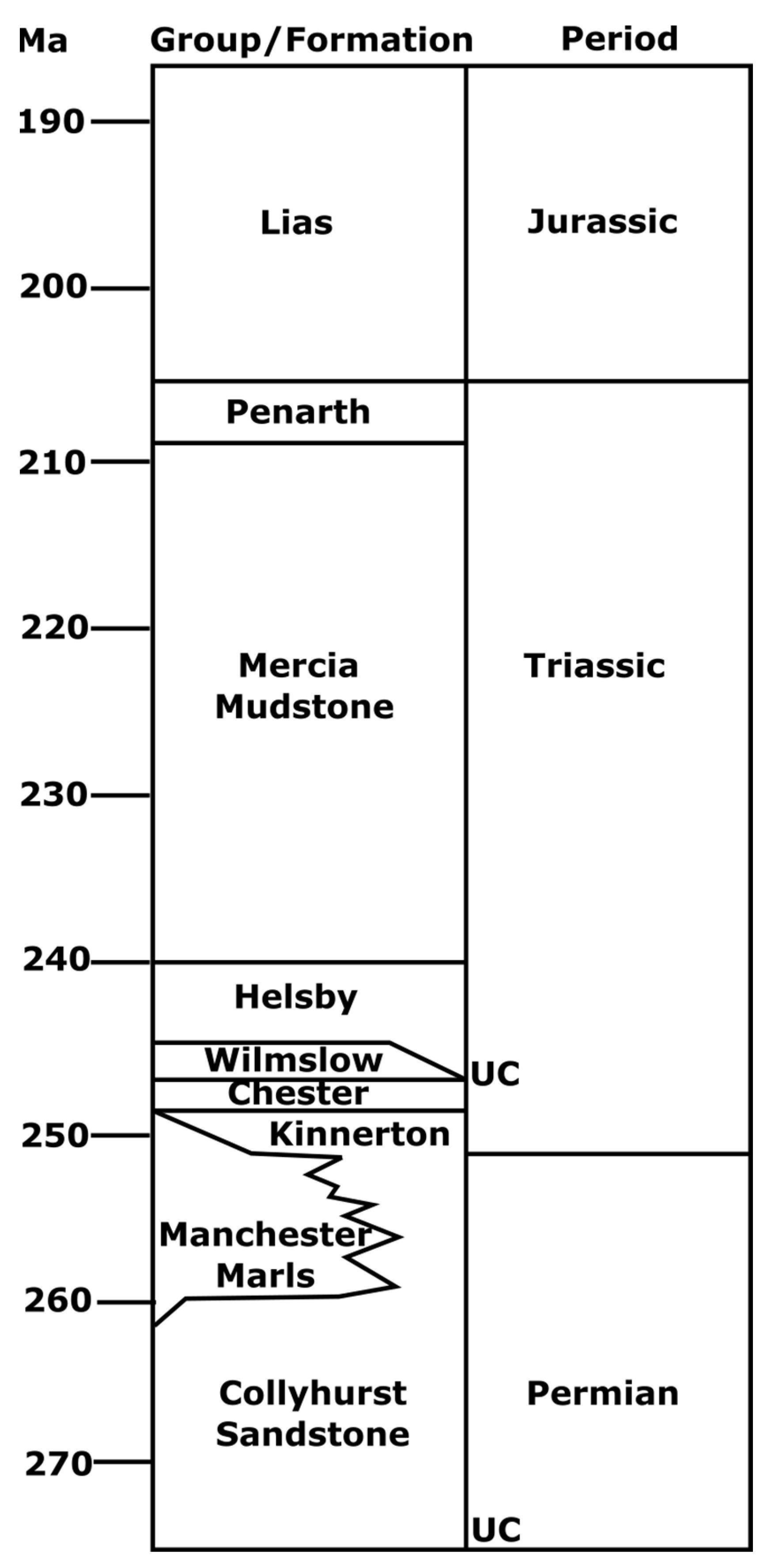
3. Geothermal Reservoirs
| Formation | Hydraulic Conductivity (m/d) | ||
|---|---|---|---|
| Reference | [23] | [13] * | [45] |
| Helsby Sandstone Formation | 2.5–10 | 3.4 | 3.1 × 10−4–15 |
| Wilmslow Sandstone Formation | 6 × 10−3–6 | 0.9 | 2.6 × 10−4–13 |
| Chester Formation | 0.5–5 | 2.6 | 2.5 × 10−4–15 |
| Kinnerton and Collyhurst Sandstone Formation | >1 | 0.9 | 3.7 × 10−5–10 |
| Formation | Porosity (%) | ||
|---|---|---|---|
| Reference | [23] | [13] | [45] |
| Helsby Sandstone Formation | 25–30 | 14–30 | 20–33 |
| Wilmslow Sandstone Formation | 13–30 | 8–30 | 6–35 |
| Chester Formation | 20–30 | 9–30 | 11–29 |
| Kinnerton and Collyhurst Sandstone Formation | 20–24 | 9–17 | 13–32 |
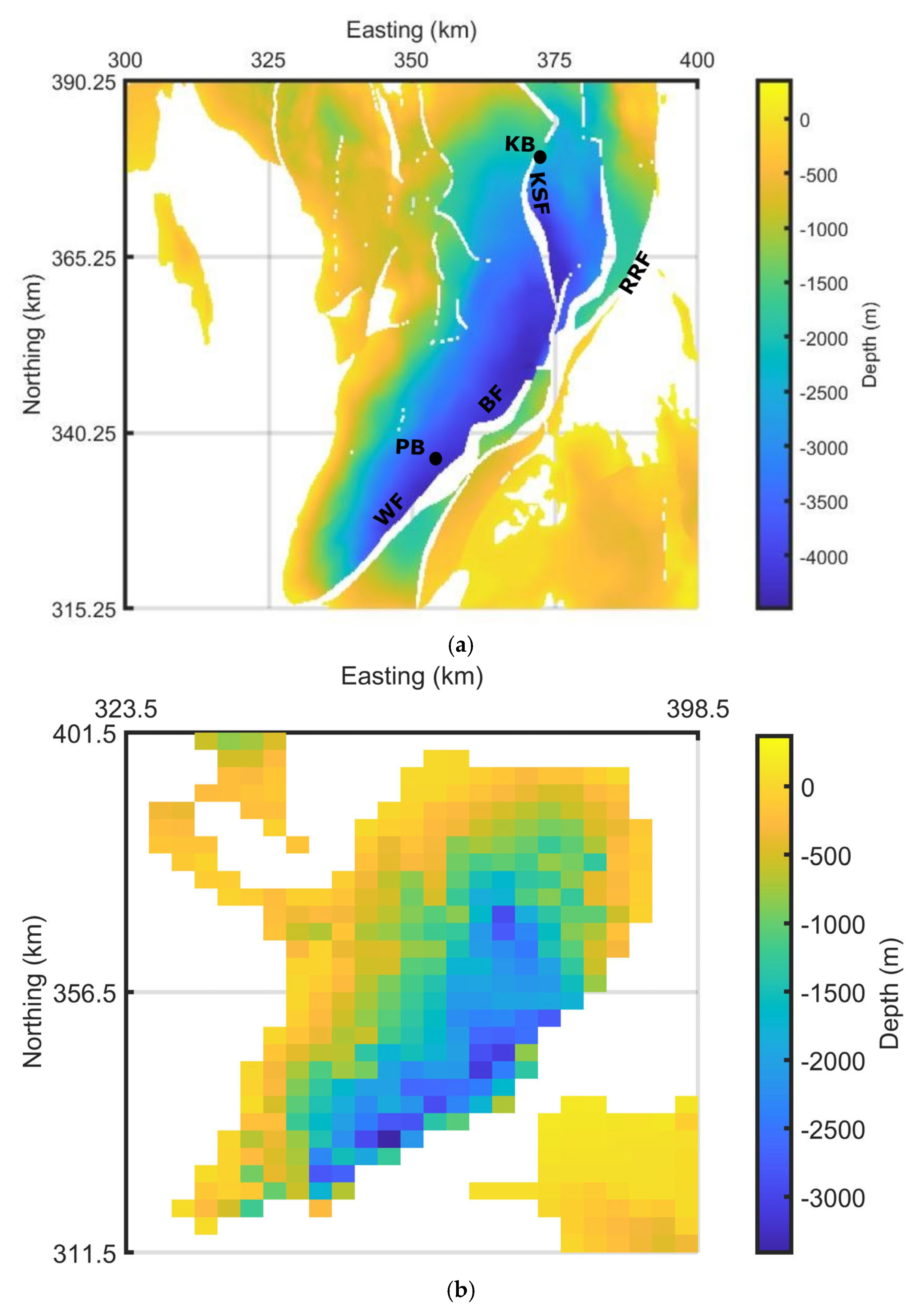

4. Geothermal Resources
4.1. Methodology
| Content | Geothermal Resource (EJ) | ||
| - | [13] | [16] * | [14] |
| Triassic Sandstones | 30 | 44.1 | 36 |
| Permian Sandstones | 35 | 39 | |
| Parameter | Value | Units | Reference |
|---|---|---|---|
| Surface Temperature | 10 | °C | - |
| Porosity | 20 | % | [16] |
| Specific Heat Capacity of Fluid | 4200 | Jkg−1 °C−1 | [69] |
| Density of Fluid | 1050 | kg/m3 | [23] |
| Specific Heat Capacity of Matrix | 1100 | Jkg−1 °C−1 | [69] |
| Density of Matrix | 2450 | kg/m3 | [69] |
4.2. Results
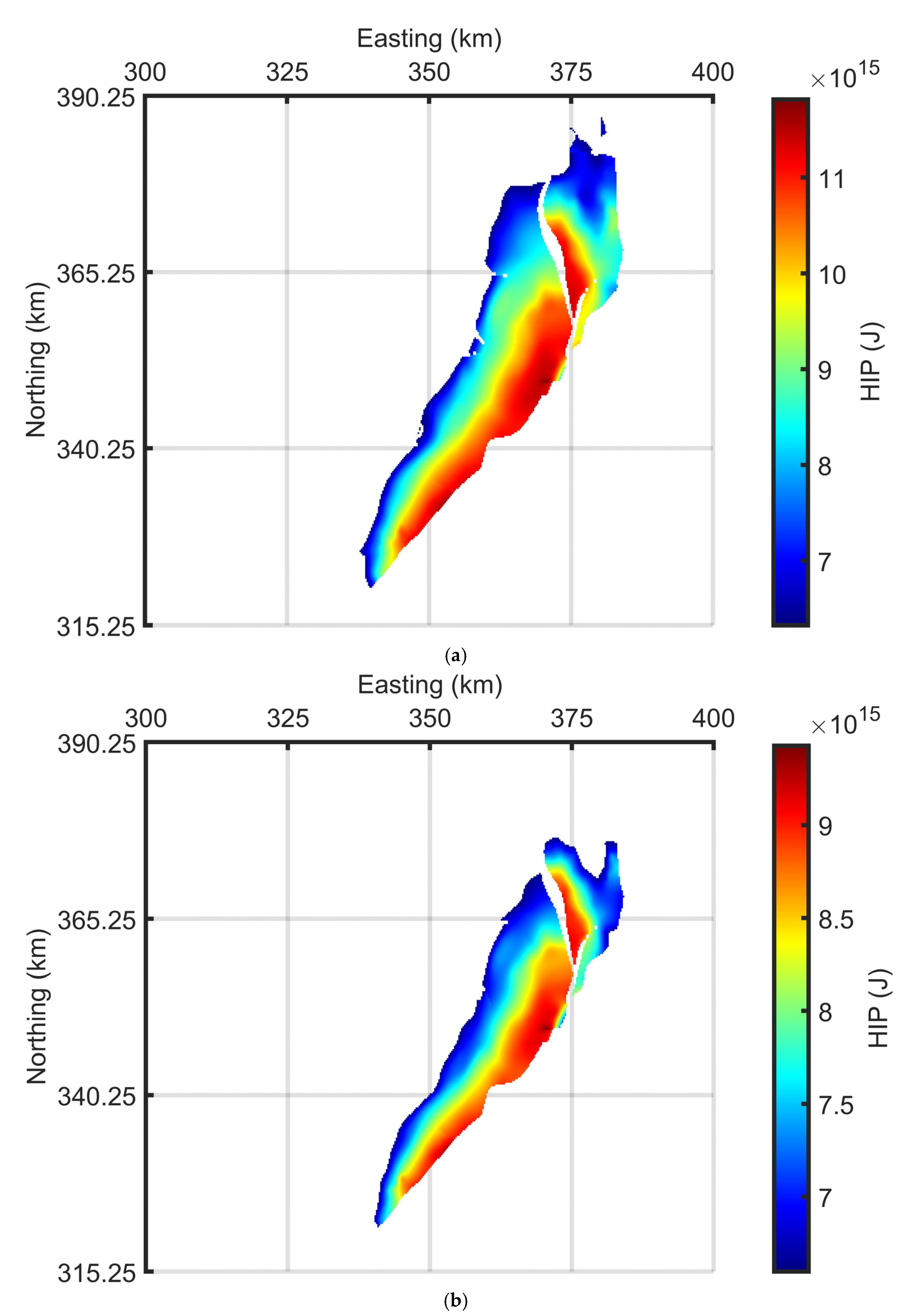
| Geothermal Gradient (°C/km) | |||
|---|---|---|---|
| 20 | 91 | 4.6 | 4.8 |
| 27 | 144 | 7.2 | 7.6 |
5. Discussions
6. Conclusions
Funding
Data Availability Statement
Acknowledgments
Conflicts of Interest
References
- Huttrer, G.W. Geothermal power generation in the world 2015–2020 update report. In Proceedings of the World Geothermal Congress, Reykjavik, Iceland, 27 April–1 May 2020; Volume 1. [Google Scholar]
- BEIS. Opportunity Areas for District Heating Networks in the UK. National Comprehensive Assessment of the Potential for Efficient Heating and Cooling. 2021. Available online: https://assets.publishing.service.gov.uk/government/uploads/system/uploads/attachment_data/file/1015585/opps_for_dhnnca_hc.pdf (accessed on 24 January 2023).
- Lindroos, T.J.; Mäki, E.; Koponen, K.; Hannula, I.; Kiviluoma, J.; Raitila, J. Replacing fossil fuels with bioenergy in district heating–Comparison of technology options. Energy 2021, 231, 120799. [Google Scholar] [CrossRef]
- Gluyas, J.; Adams, C.; Busby, J.; Craig, J.; Hirst, C.; Manning, D.; McCay, A.; Narayan, N.; Robinson, H.; Watson, S.; et al. Keeping warm: A review of deep geothermal potential of the UK. Proc. Inst. Mech. Eng. Part A J. Power Energy 2018, 232, 115–126. [Google Scholar] [CrossRef]
- Watson, S.M.; Falcone, G.; Westaway, R. Repurposing hydrocarbon wells for geothermal use in the UK: The on-shore fields with the greatest potential. Energies 2020, 13, 3541. [Google Scholar] [CrossRef]
- Brown, C.S.; Cassidy, N.J.; Egan, S.S.; Griffiths, D. Thermal and Economic Analysis of Heat Exchangers as Part of a Geothermal District Heating Scheme in the Cheshire Basin, UK. Energies 2022, 15, 1983. [Google Scholar] [CrossRef]
- Baria, R.; MacPherson-Grant, G.; Baumgaertner, J.; Jupe, A.; Cowles, J. Engineered Geothermal Program in the UK. In Proceedings of the World Geothermal Congress, Bali, Indonesia, 25–29 April 2010. [Google Scholar]
- Curtis, R.; Ledingham, P.; Law, R.; Bennett, T. Geothermal energy use, country update for United Kingdom. In Proceedings of the European Geothermal Congress, Pisa, Italy, 3–7 June 2013; pp. 1–9. [Google Scholar]
- Somma, R.; Blessent, D.; Raymond, J.; Constance, M.; Cotton, L.; Natale, G.; Fedele, A.; Jurado, M.; Marcia, K.; Miranda, M.; et al. Review of Recent Drilling Projects in Unconventional Geothermal Resources at Campi Flegrei Caldera, Cornubian Batholith, and Williston Sedimentary Basin. Energies 2021, 14, 3306. [Google Scholar] [CrossRef]
- Farndale, H.; Law, R. An Update on the United Downs Geothermal Power Project, Cornwall, UK. In Proceedings of the 47th Workshop on Geothermal Reservoir Engineering, Stanford, CA, USA, 7–9 February 2022. [Google Scholar]
- Howell, L.; Brown, C.S.; Egan, S.S. Deep geothermal energy in northern England: Insights from 3D finite difference temperature modelling. Comput. Geosci. 2021, 147, 104661. [Google Scholar] [CrossRef]
- Brown, C.S. Regional geothermal resource assessment of hot dry rocks in Northern England using 3D geological and thermal models. Geothermics 2022, 105, 102503. [Google Scholar] [CrossRef]
- Downing, R.A.; Gray, D.A. (Eds.) Geothermal Energy–The Potential in the 495 United Kingdom; HMSO: London, UK, 1986. [Google Scholar]
- Rollin, K.E.; Kirby, G.A.; Rowley, W.J.; Buckley, D.K. Atlas of Geothermal Resources in Europe: UK Revision; Technical Report WK/95/07; British Geological Survey: Keyworth, UK, 1995. [Google Scholar]
- Pasquali, R.; O’Neill, N.; Reay, D.; Waugh, T. The geothermal potential of Northern Ireland. In Proceedings of the World Geothermal Congress 2010, Bali, Indonesia, 25–29 April 2010. [Google Scholar]
- Jackson, T. Geothermal Potential in Great Britain and Northern Ireland; Sinclair Knight Merz: Sydney, NSW, Australia, 2012. [Google Scholar]
- Busby, J. Geothermal energy in sedimentary basins in the UK. Hydrogeol. J. 2014, 22, 129–141. [Google Scholar] [CrossRef]
- Busby, J. Geothermal prospects in the United Kingdom. In Proceedings of the World Geothermal Congress 2010, Bali, Indonesia, 25–29 April 2010. [Google Scholar]
- Smith, M. Southampton energy scheme. In Proceedings of the World Geothermal Congress, IGA, Tokyo, Japan, 28 May–10 June 2000. [Google Scholar]
- Batchelor, T.; Curtis, R.; Busby, J. Geothermal Energy Use, Country Update for United Kingdom. In Proceedings of the World Geothermal Congress, Reykjavik, Iceland, 24–27 October 2021. [Google Scholar]
- Hirst, C.M.; Gluyas, J.G.; Adams, C.A.; Mathias, S.A.; Bains, S.; Styles, P. UK Low Enthalpy Geothermal Resources: The Cheshire Basin. In Proceedings of the World Geothermal Congress 2015, Melbourne, VIC, Australia, 19–25 April 2015. [Google Scholar]
- Naylor, H.; Turner, P.; Vaughan, D.J.; Boyce, A.J.; Fallick, A.E. Genetic studies of red bed mineralization in the Triassic of the Cheshire Basin, northwest England. J. Geol. Soc. 1989, 146, 685–699. [Google Scholar] [CrossRef]
- Plant, J.A.; Jones, D.G.; Haslam, H.W. (Eds.) The Cheshire Basin: Basin Evolution, Fluid Movement and Mineral Resources in a Permo-Triassic Rift Setting; British Geological Survey: Nottingham, UK, 1999. [Google Scholar]
- Routledge, K.; Williams, J.; Lehdonvirta, H.; Kuivala, J.-P.; Fagerstrom, O. Heat Network Mapping for Leighton West; Report Number: 298–692; Cheshire East Council: Crewe, UK, 2014. [Google Scholar]
- Brown, C.S. Modelling, Characterisation and Optimisation of Deep Geothermal Energy in the Cheshire Basin. Ph.D. Thesis, University of Birmingham, Birmingham, UK, 2020. [Google Scholar]
- Morchio, S.; Fossa, M. Thermal modeling of deep borehole heat exchangers for geothermal applications in densely populated urban areas. Therm. Sci. Eng. Prog. 2019, 13, 100363. [Google Scholar] [CrossRef]
- Beier, R.A.; Fossa, M.; Morchio, S. Models of thermal response tests on deep coaxial borehole heat exchangers through multiple ground layers. Appl. Therm. Eng. 2020, 184, 116241. [Google Scholar] [CrossRef]
- Brown, C.S.; Kolo, I.; Falcone, G.; Banks, D. Investigating scalability of deep borehole heat exchangers: Numerical modelling of arrays with varied modes of operation. Renew. Energy 2023, 202, 442–452. [Google Scholar] [CrossRef]
- Glennie, K.W. Permian and Triassic rifting in northwest Europe. Geol. Soc. London Spec. Publ. 1995, 91, 1–5. [Google Scholar] [CrossRef]
- Rowley, E.; White, N. Inverse modelling of extension and denudation in the East Irish Sea and surrounding areas. Earth Planet. Sci. Lett. 1998, 161, 57–71. [Google Scholar] [CrossRef]
- Woodcock, N.H.; Strachan, R.A. Geological History of Britain and Ireland; John Wiley & Sons: Hoboken, NJ, USA, 2009. [Google Scholar]
- Hough, E.; Schofield, D.; Pharaoh, T.; Haslam, R.; Loveless, S.; Bloomfield, J.P.; Lee, J.R.; Baptie, B.; Shaw, R.P.; Bide, T.; et al. National Geological Screening: Central England Region; British Geological Survey: Nottingham, UK, 2018. [Google Scholar]
- Bloomfield, J.P.; Moreau, M.F.; Newell, A.J. Characterization of permeability distributions in six lithofacies from the Helsby and Wilmslow sandstone formations of the Cheshire Basin, UK. Geol. Soc. London Spec. Publ. 2006, 263, 83–101. [Google Scholar] [CrossRef]
- Chadwick, R.A. Fault analysis of the Cheshire Basin, NW England. Geol. Soc. London Spec. Publ. 1997, 124, 297–313. [Google Scholar] [CrossRef]
- Rayner, D.H. Stratigraphy of the British Isles, 2nd ed.; Cambridge University Press: Cambridge, UK, 1981. [Google Scholar]
- Williams, G.D.; Eaton, G.P. Stratigraphic and structural analysis of the Late Palaeozoic–Mesozoic of NE Wales and Liverpool Bay: Implications for hydrocarbon prospectivity. J. Geol. Soc. 1993, 150, 489–499. [Google Scholar] [CrossRef]
- Wilson, A.A. The Mercia Mudstone Group (Trias) of the Cheshire Basin. Proc. Yorks. Geol. Soc. 1993, 49, 171–188. [Google Scholar] [CrossRef]
- Mikkelsen, P.W.; Floodpage, J.B. The hydrocarbon potential of the Cheshire Basin. Geol. Soc. London Spé;c. Publ. 1997, 124, 161–183. [Google Scholar] [CrossRef]
- Griffiths, K.J.; Shand, P.; Ingram, J. Baseline Report Series: 8. The Permo-Triassic Sandstones of Manchester and East Cheshire British Geological Survey Commissioned Report No. CR/03/265N; British Geological Survey: Nottingham, UK, 2003. [Google Scholar]
- Ambrose, K.; Hough, E.; Smith, N.J.P.; Warrington, G. Lithostratigraphy of the Sherwood Sandstone Group of England, Wales and South-West Scotland; British Geological Survey: Nottingham, UK, 2014. [Google Scholar]
- Lovelock, P.E.R. Aquifer properties of PermoTriassic sandstones in the United Kingdom. Geol. Surv. 1977, 56, 646–665. [Google Scholar]
- Barker, R.D.; Tellam, J.H. Fluid Flow and Solute Movement in Sandstones: The Onshore UK Permo-Triassic Red Bed Sequence; Geological Society of London: London, UK, 2006. [Google Scholar]
- Evans, D.J.; Rees, J.G.; Holloway, S. The Permian to Jurassic stratigraphy and structural evolution of the central Cheshire Basin. J. Geol. Soc. 1993, 150, 857–870. [Google Scholar] [CrossRef]
- Mountney, N.P.; Thompson, D.B. Stratigraphic evolution and preservation of aeolian dune and damp/wet interdune strata: An example from the Triassic Helsby Sandstone Formation, Cheshire Basin, UK. Sedimentology 2002, 49, 805–833. [Google Scholar] [CrossRef]
- Allen, D.J.; Brewerton, L.J.; Coleby, L.M.; Gibbs, B.R.; Lewis, M.A.; MacDonald, A.M.; Wagstaff, S.J.; Williams, A.T. The Physical Properties of Major Aquifers in England and Wales; British Geological Survey: Nottingham, UK, 1997. [Google Scholar]
- Colter, V.T.; Barr, K.W. Recent Developments in the Geology of the Irish Sea and Cheshire Basins. In Petroleum and the Continental Shelf of North-West Europe. 1. Geology; Applied Science Publishers: Barking, UK, 1975; pp. 61–73. [Google Scholar]
- Thompson, J.; Parkes, D.; Hough, E.; Wakefield, O. Using core and outcrop analogues to predict flow pathways in the subsurface: Examples from the Triassic sandstones of north Cheshire, UK. Adv. Geosci. 2019, 49, 121–127. [Google Scholar] [CrossRef]
- Colter, V.S.; Ebburn, J. The petrography and reservoir properties of some Triassic sandstones from the Northern Irish Sea Basin. Geol. Soc. 1978, 135, 57–62. [Google Scholar] [CrossRef]
- Skinner, A.C. Groundwater in the regional water supply strategy of the English Midlands. In Optimal Development and Management of Groundwater; British Geological Survey: Nottingham, UK, 1977; pp. A1–A12. [Google Scholar]
- Moore, K.R.; Holländer, H.M. Evaluation of NaCl and MgCl2 heat exchange fluids in a deep binary geothermal system in a sedimentary halite formation. Geotherm. Energy 2021, 9, 1–23. [Google Scholar] [CrossRef]
- Smith, N. Variscan inversion within the Cheshire Basin, England: Carboniferous evolution north of the Variscan Front. Tectonophysics 1999, 309, 211–225. [Google Scholar] [CrossRef]
- Vincent, C.J.; Merriman, R.J. Thermal Modelling of the Cheshire Basin Using BasinModTM; British Geological Survey: Nottingham, UK, 2004. [Google Scholar]
- BGS. Borehole Scan for SJ53SE3 PREES 1. 2022. Available online: https://shop.bgs.ac.uk/Shop/search/boreholeIndex/RF/q/SJ53SE3 (accessed on 27 October 2022).
- Wight, A. Knutsford NO.1. Well Completion Report. 1974. Available online: http://scans.bgs.ac.uk/sobi_scans/boreholes/749082/images/12269805.html (accessed on 27 October 2022).
- UKOGL. UK Onshore Geophysical Library. 2022. Available online: https://ukogl.org.uk/map/?v=current (accessed on 27 October 2022).
- Hirst, C. The Geothermal Potential of Low Enthalpy Deep Sedimentary Basins in the UK. Ph.D. Thesis, Durham University, Durham, Germany, 2017. [Google Scholar]
- Burley, A.J.; Smith, I.F.; Lee, M.K.; Burgess, W.G.; Edmunds, W.M.; Arthur, M.J.; Bennett, J.R.P.; Carruthers, R.M.; Downing, R.A.; Houghton, M.T. Preliminary Assessment of the Geothermal Potential of the United Kingdom. In Advances in European Geothermal Research; Strub, A.S., Ungemach, P., Eds.; Springer: Dordrecht, The Netherlands, 1980; pp. 99–108. [Google Scholar]
- British Geological Survey. BGS LithoFrame. Available online: https://www.bgs.ac.uk/datasets/bgs-lithoframe/ (accessed on 17 August 2022).
- British Geological Survey. Groundwater Science—Shale Gas—Aquifers and Shales. Available online: https://www2.bgs.ac.uk/groundwater/shaleGas/aquifersAndShales/data.html (accessed on 17 August 2022).
- Burley, A.J.; Edmunds, W.M.; Gale, I.N. Investigation of the Geothermal Potential of the UK: Catalogue of Geo-Thermal Data for the Land Area of the United Kingdom; British Geological Survey: Nottingham, UK, 1984. [Google Scholar]
- Muffler, P.; Cataldi, R. Methods for regional assessment of geothermal resources. Geothermics 1978, 7, 53–89. [Google Scholar] [CrossRef]
- Ciriaco, A.E.; Zarrouk, S.J.; Zakeri, G. Geothermal resource and reserve assessment methodology: Overview, analysis and future directions. Renew. Sustain. Energy Rev. 2019, 119, 109515. [Google Scholar] [CrossRef]
- Lyden, A.; Brown, C.S.; Kolo, I.; Falcone, G.; Friedrich, D. Seasonal thermal energy storage in smart energy sys-tems: District-level applications and modelling approaches. Renew. Sustain. Energy Rev. 2022, 167, 112760. [Google Scholar] [CrossRef]
- Agemar, T.; Weber, J.; Moeck, I.S. Assessment and Public Reporting of Geothermal Resources in Germany: Review and Outlook. Energies 2018, 11, 332. [Google Scholar] [CrossRef]
- Rubio-Maya, C.; Díaz, V.A.; Martínez, E.P.; Belman-Flores, J. Cascade utilization of low and medium enthalpy geothermal resources—A review. Renew. Sustain. Energy Rev. 2015, 52, 689–716. [Google Scholar] [CrossRef]
- Alimonti, C.; Soldo, E.; Scrocca, D. Looking forward to a decarbonized era: Geothermal potential assessment for oil & gas fields in Italy. Geothermics 2021, 93, 102070. [Google Scholar] [CrossRef]
- Barcelona, H.; Senger, M.; Yagupsky, D. Resource assessment of the Copahue geothermal field. Geothermics 2021, 90, 101987. [Google Scholar] [CrossRef]
- Limberger, J.; Boxem, T.; Pluymaekers, M.; Bruhn, D.; Manzella, A.; Calcagno, P.; Beekman, F.; Cloetingh, S.; van Wees, J.-D. Geothermal energy in deep aquifers: A global assessment of the resource base for direct heat utilization. Renew. Sustain. Energy Rev. 2018, 82, 961–975. [Google Scholar] [CrossRef]
- Brown, C.S.; Cassidy, N.J.; Egan, S.S.; Griffiths, D. A sensitivity analysis of a single extraction well from deep geothermal aquifers in the Cheshire Basin, UK. Q. J. Eng. Geol. Hydrogeol. 2022, 55, qjegh2021-131. [Google Scholar] [CrossRef]
- Regeneris. The Economic Impact of Crewe’s Deep Geothermal District Heating Scheme. A Final Report by Regeneris Consulting; For the Cheshire East Council: Cheshire East, UK, 2016. [Google Scholar]
- Brown, C.S.; Cassidy, N.J.; Egan, S.S.; Griffiths, D. Numerical modelling of deep coaxial borehole heat exchangers in the Cheshire Basin, UK. Comput. Geosci. 2021, 152, 104752. [Google Scholar] [CrossRef]
- Brown, C.S.; Kolo, I.; Falcone, G.; Banks, D. Repurposing a deep geothermal exploration well for borehole thermal energy storage: Implications from statistical modelling and sensitivity analysis. Appl. Therm. Eng. 2023, 220, 119701. [Google Scholar] [CrossRef]
- Kolo, I.; Brown, C.S.; Falcone, G.; Banks, D. Closed-loop Deep Borehole Heat Exchanger: Newcastle Science Central Deep Geothermal Borehole. In Proceedings of the European Geothermal Congress 2022, Berlin, Germany, 17–21 October 2022. [Google Scholar]
- Westaway, R. Deep Geothermal Single Well heat production: Critical appraisal under UK conditions. Q. J. Eng. Geol. Hydrogeol. 2018, 51, 424–449. [Google Scholar] [CrossRef]
- Arup. Cheshire East Energy Planning: Review of Geothermal Potential in Cheshire East; Cheshire East Council: Cheshire East, UK, 2013; pp. 1–19. [Google Scholar]
- Atkins. Deep Geothermal Review Study Final Report; DECC: Duluth, MN, USA, 2013. [Google Scholar]
- Gandy, C.; Clarke, L.; Banks, D.; Younger, P. Predictive modelling of groundwater abstraction and artificial recharge of cooling water. Q. J. Eng. Geol. Hydrogeol. 2010, 43, 279–288. [Google Scholar] [CrossRef]
- Rees, S.; Curtis, R. National Deployment of Domestic Geothermal Heat Pump Technology: Observations on the UK Experience 1995–2013. Energies 2014, 7, 5460–5499. [Google Scholar] [CrossRef]
- Underwood, C. On the Design and Response of Domestic Ground-Source Heat Pumps in the UK. Energies 2014, 7, 4532–4553. [Google Scholar] [CrossRef]
- Busby, J.; Terrington, R. Assessment of the resource base for engineered geothermal systems in Great Britain. Geotherm. Energy 2017, 5, 7. [Google Scholar] [CrossRef]

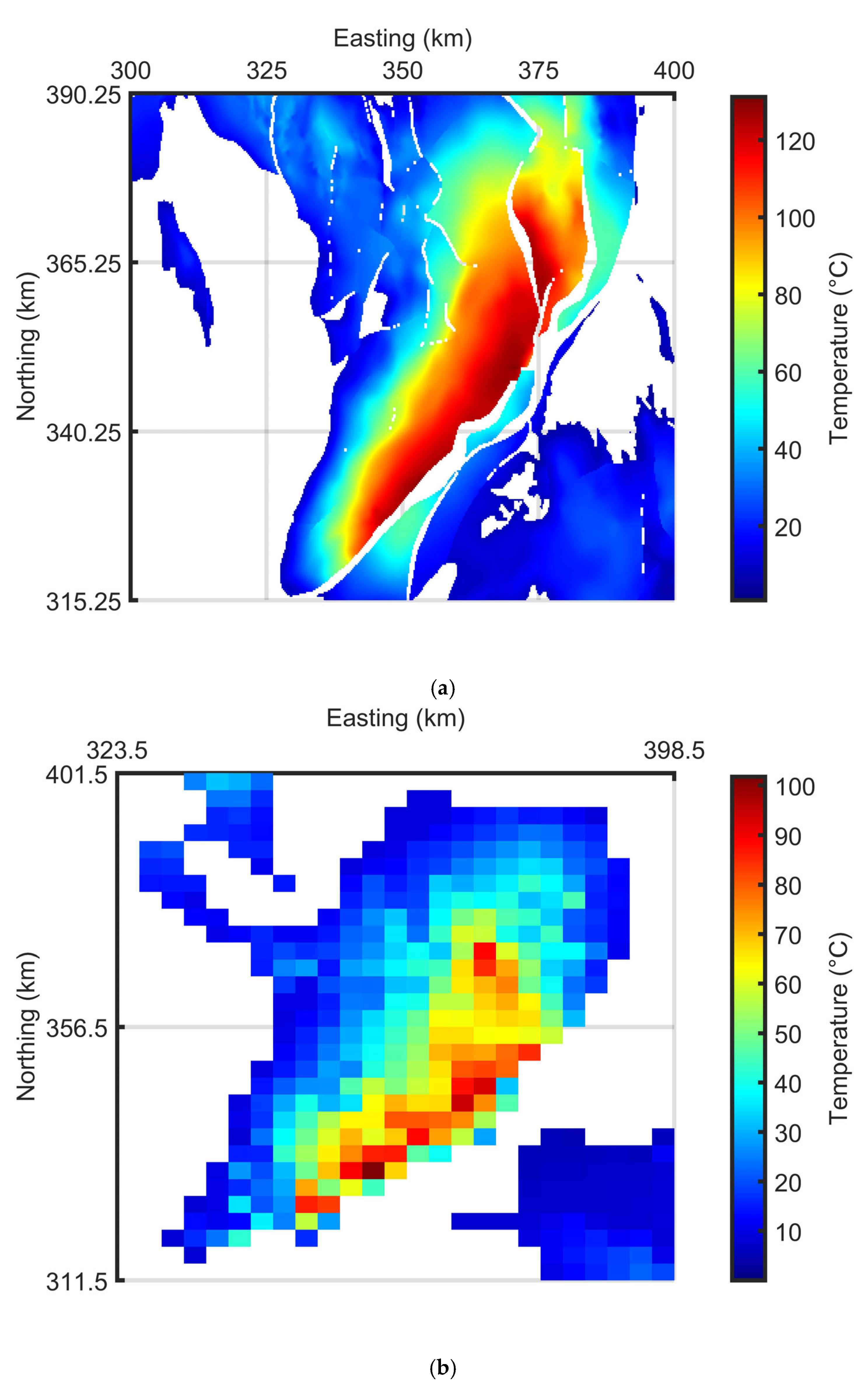

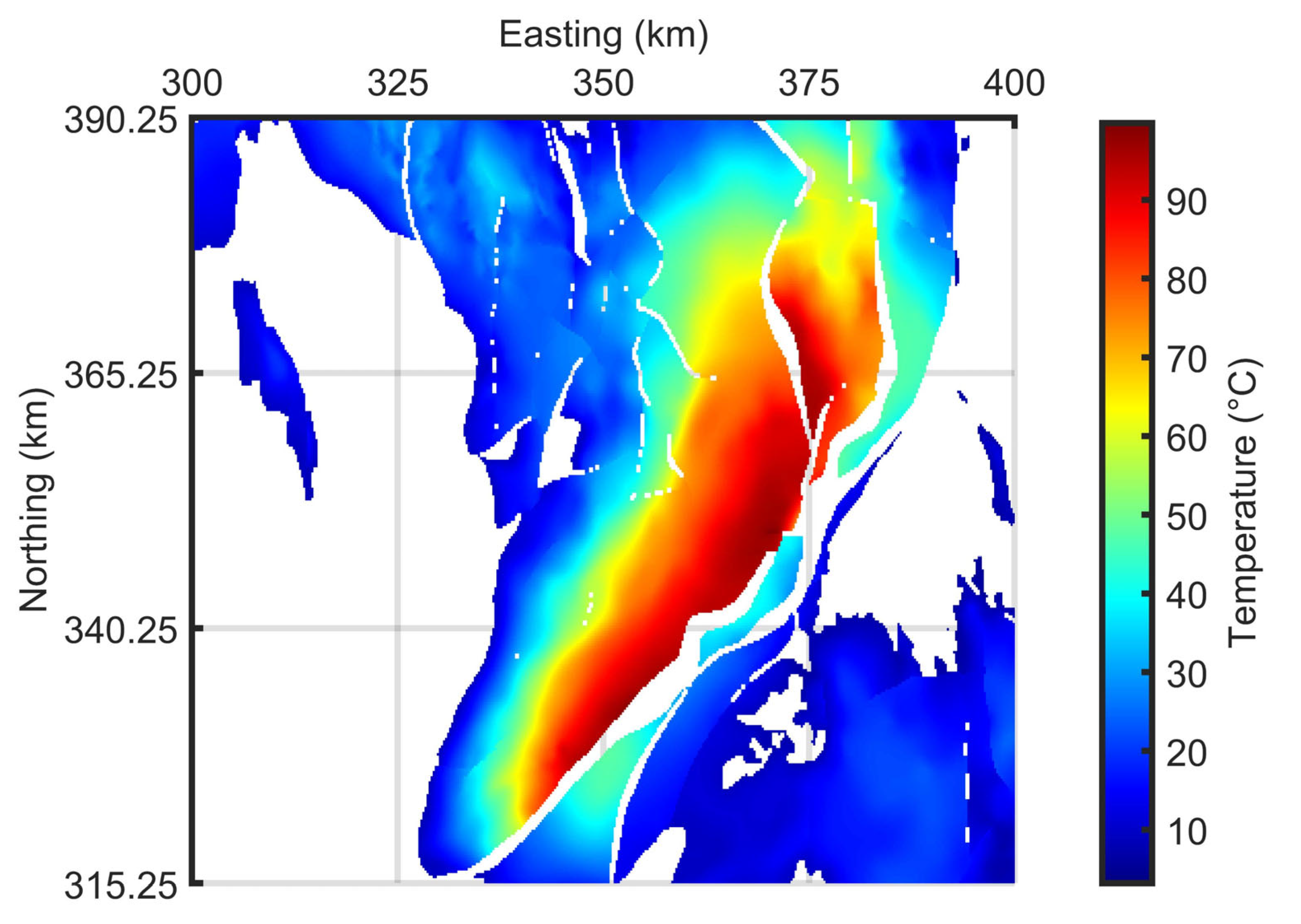
| Geothermal Gradient (°C/km) | Porosity (%) | |||
|---|---|---|---|---|
| 20 | 6 | 84 | 4.2 | 4.4 |
| 35 | 98 | 4.9 | 5.2 | |
| 27 | 6 | 133 | 6.6 | 7 |
| 35 | 156 | 7.8 | 8.3 |
Disclaimer/Publisher’s Note: The statements, opinions and data contained in all publications are solely those of the individual author(s) and contributor(s) and not of MDPI and/or the editor(s). MDPI and/or the editor(s) disclaim responsibility for any injury to people or property resulting from any ideas, methods, instructions or products referred to in the content. |
© 2023 by the author. Licensee MDPI, Basel, Switzerland. This article is an open access article distributed under the terms and conditions of the Creative Commons Attribution (CC BY) license (https://creativecommons.org/licenses/by/4.0/).
Share and Cite
Brown, C.S. Revisiting the Deep Geothermal Potential of the Cheshire Basin, UK. Energies 2023, 16, 1410. https://doi.org/10.3390/en16031410
Brown CS. Revisiting the Deep Geothermal Potential of the Cheshire Basin, UK. Energies. 2023; 16(3):1410. https://doi.org/10.3390/en16031410
Chicago/Turabian StyleBrown, Christopher Simon. 2023. "Revisiting the Deep Geothermal Potential of the Cheshire Basin, UK" Energies 16, no. 3: 1410. https://doi.org/10.3390/en16031410
APA StyleBrown, C. S. (2023). Revisiting the Deep Geothermal Potential of the Cheshire Basin, UK. Energies, 16(3), 1410. https://doi.org/10.3390/en16031410







